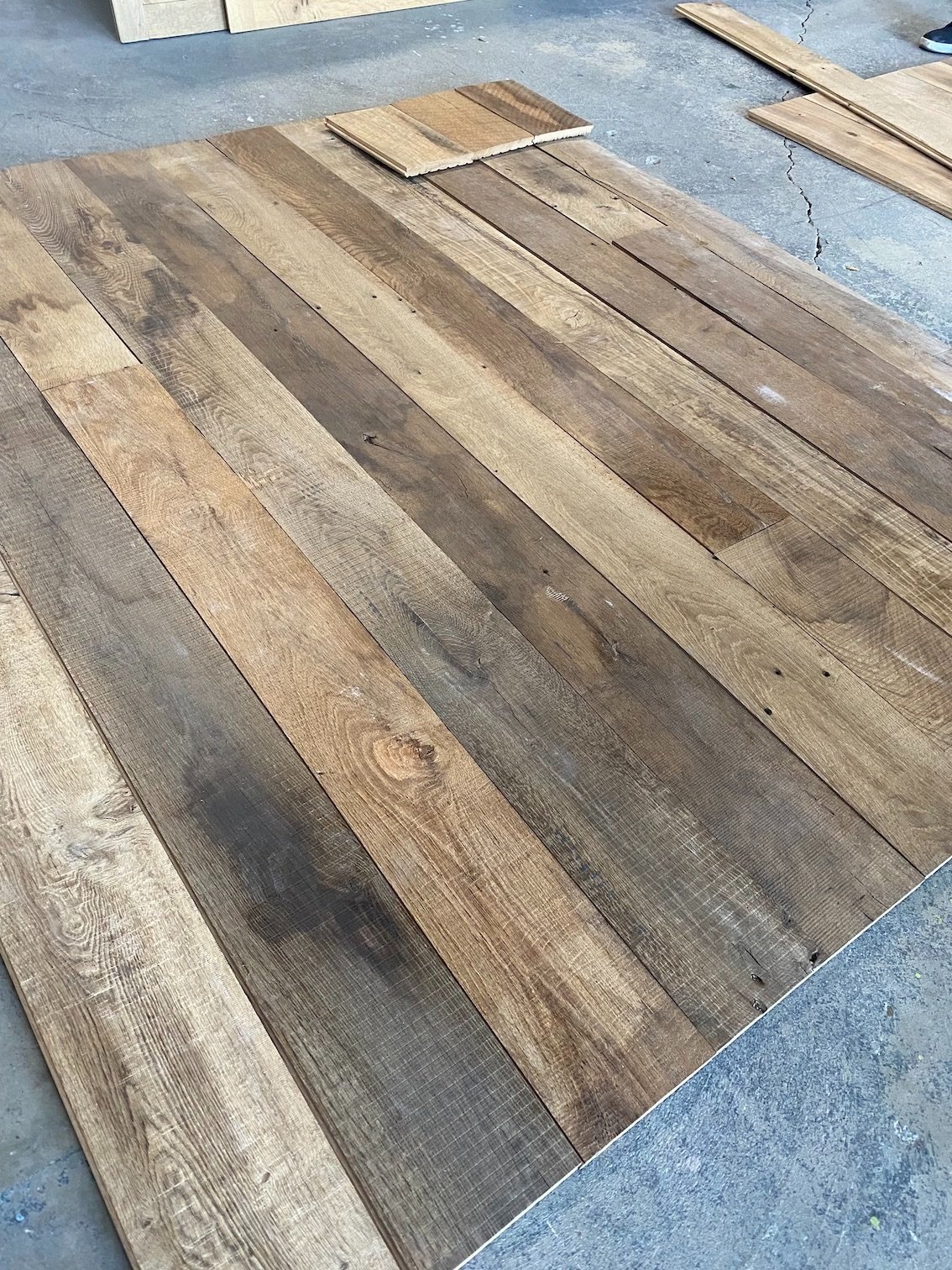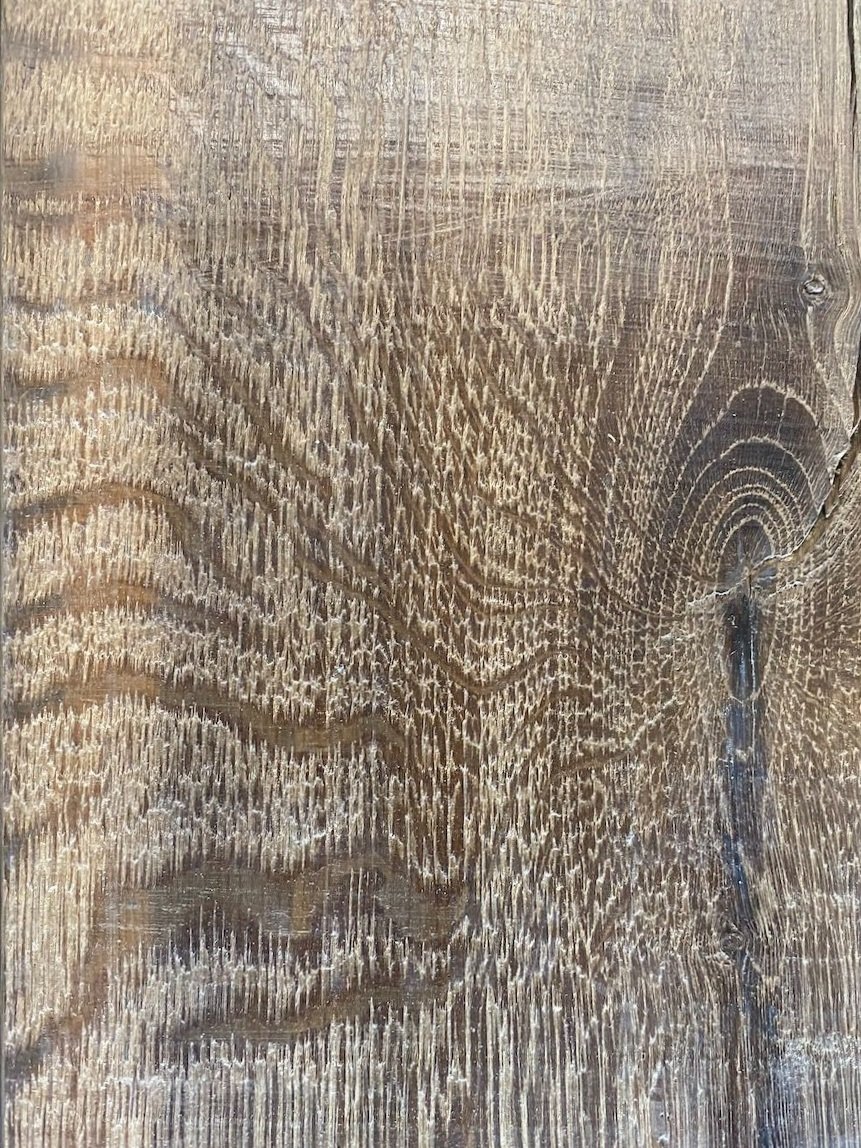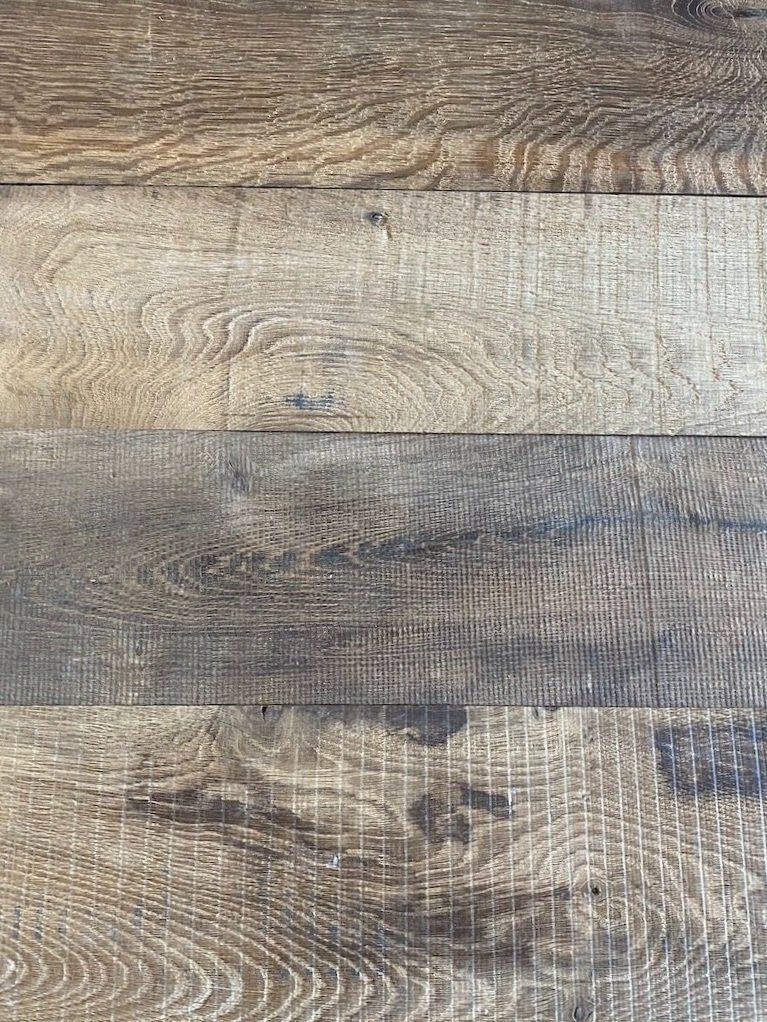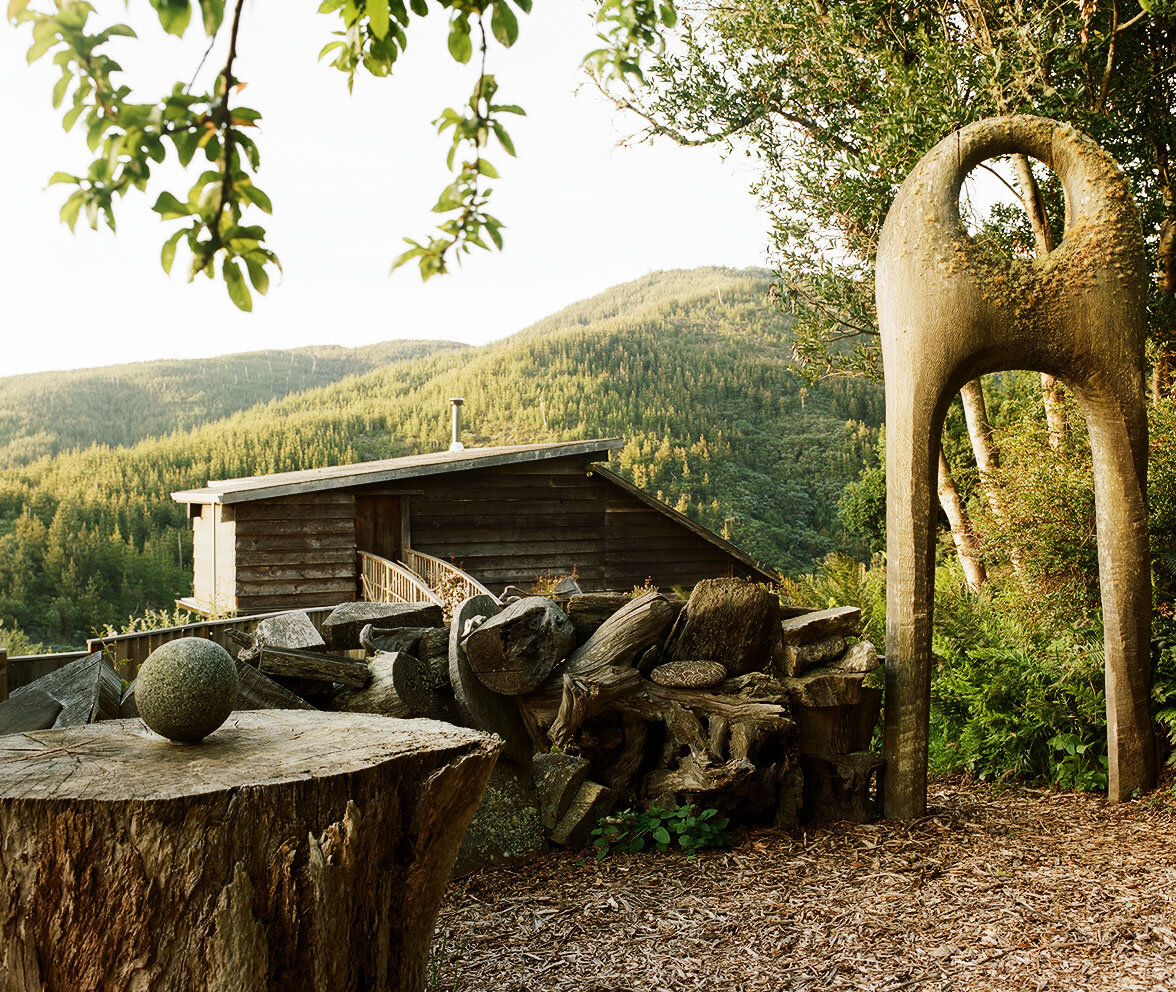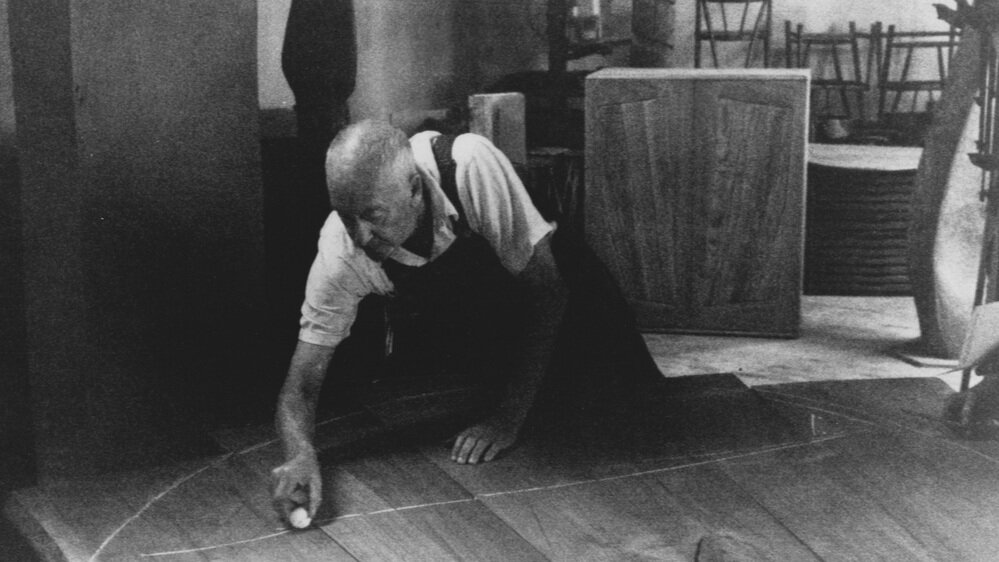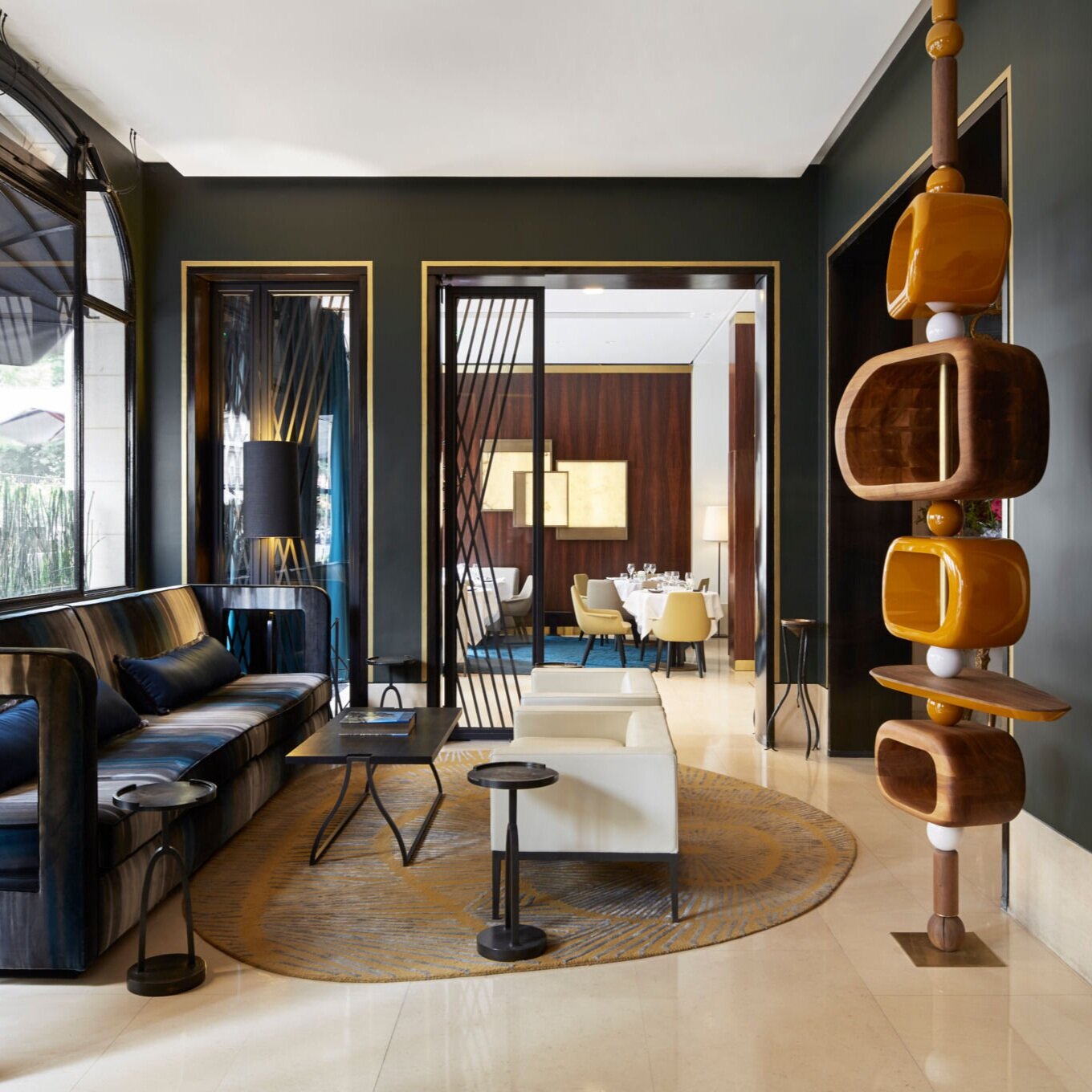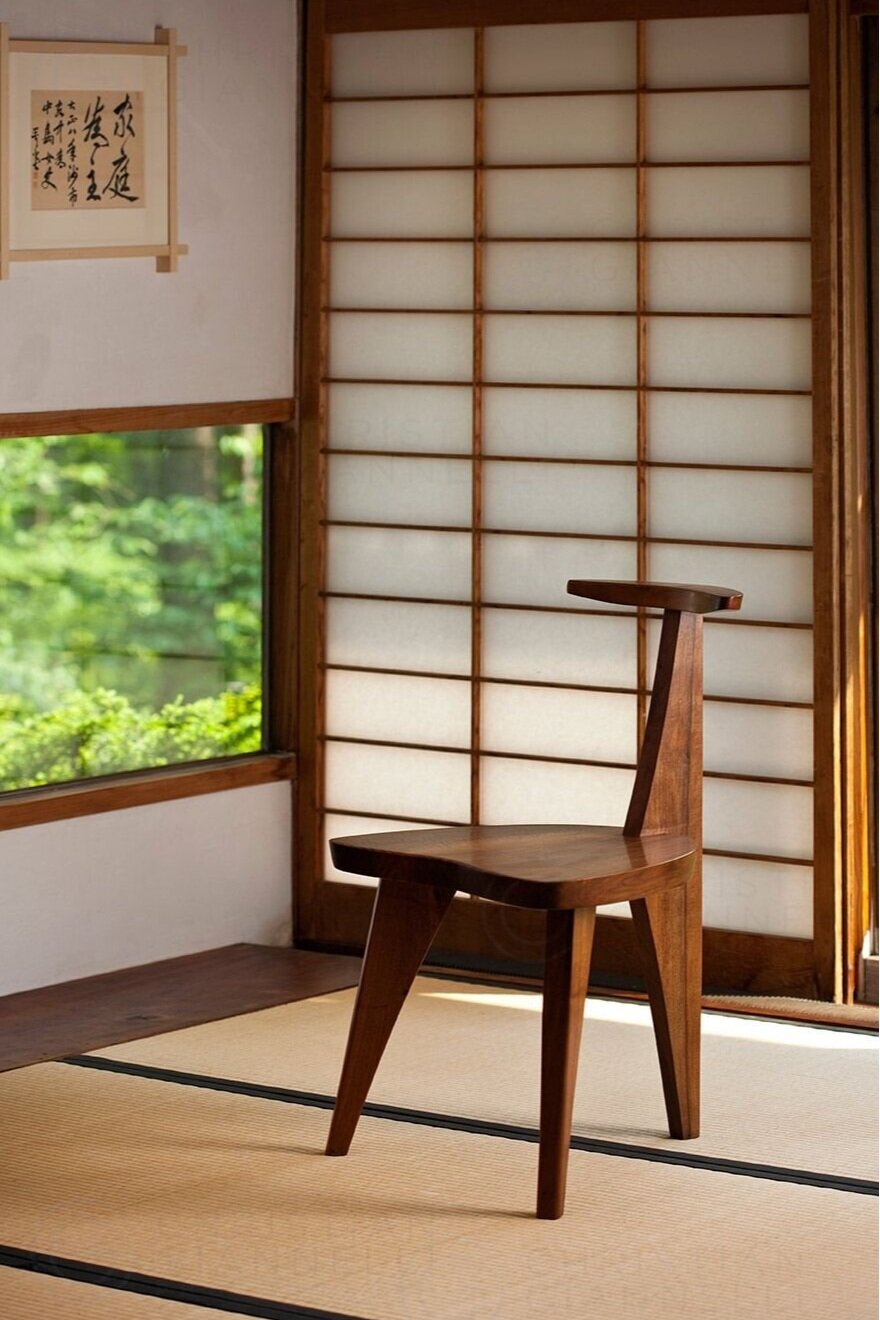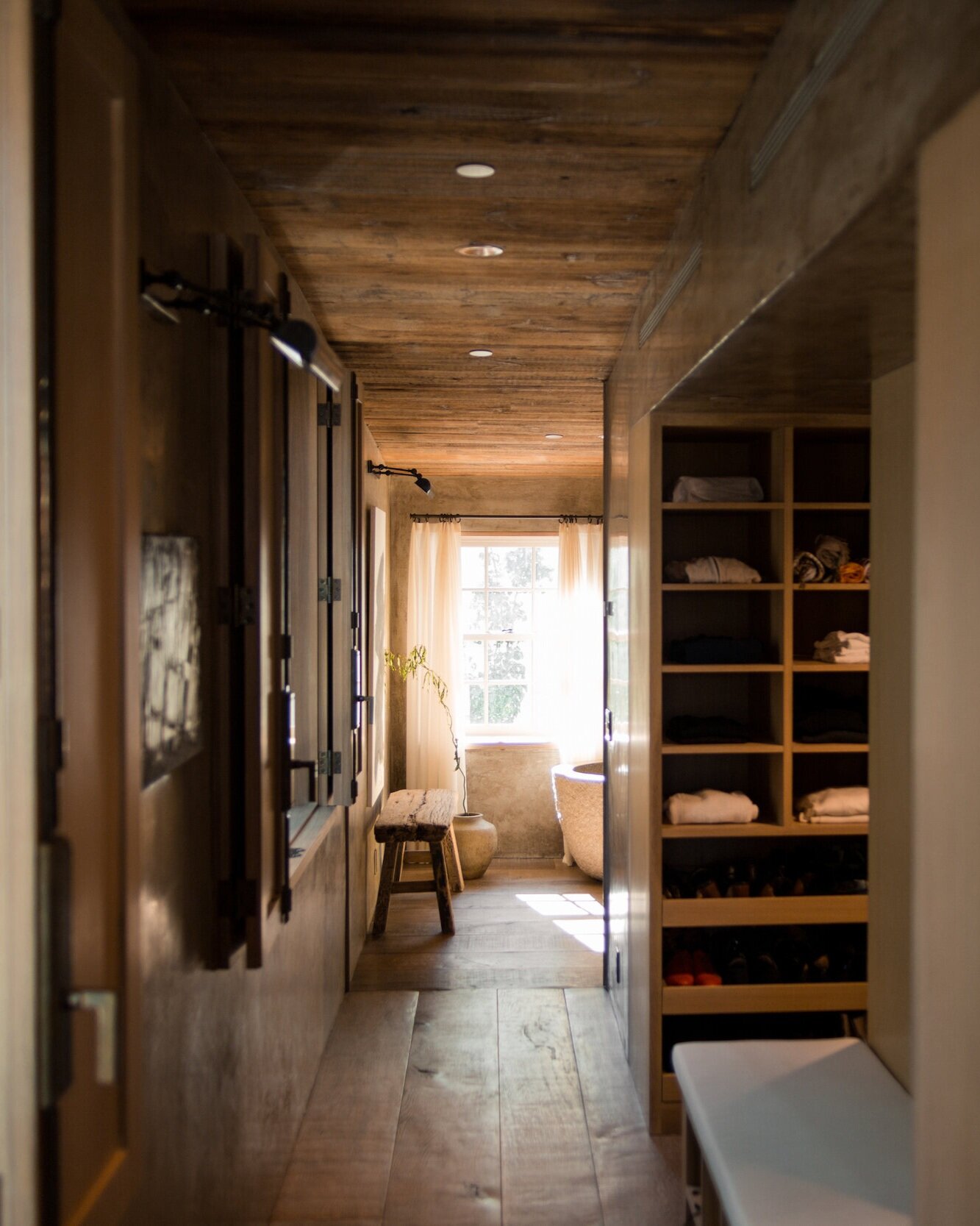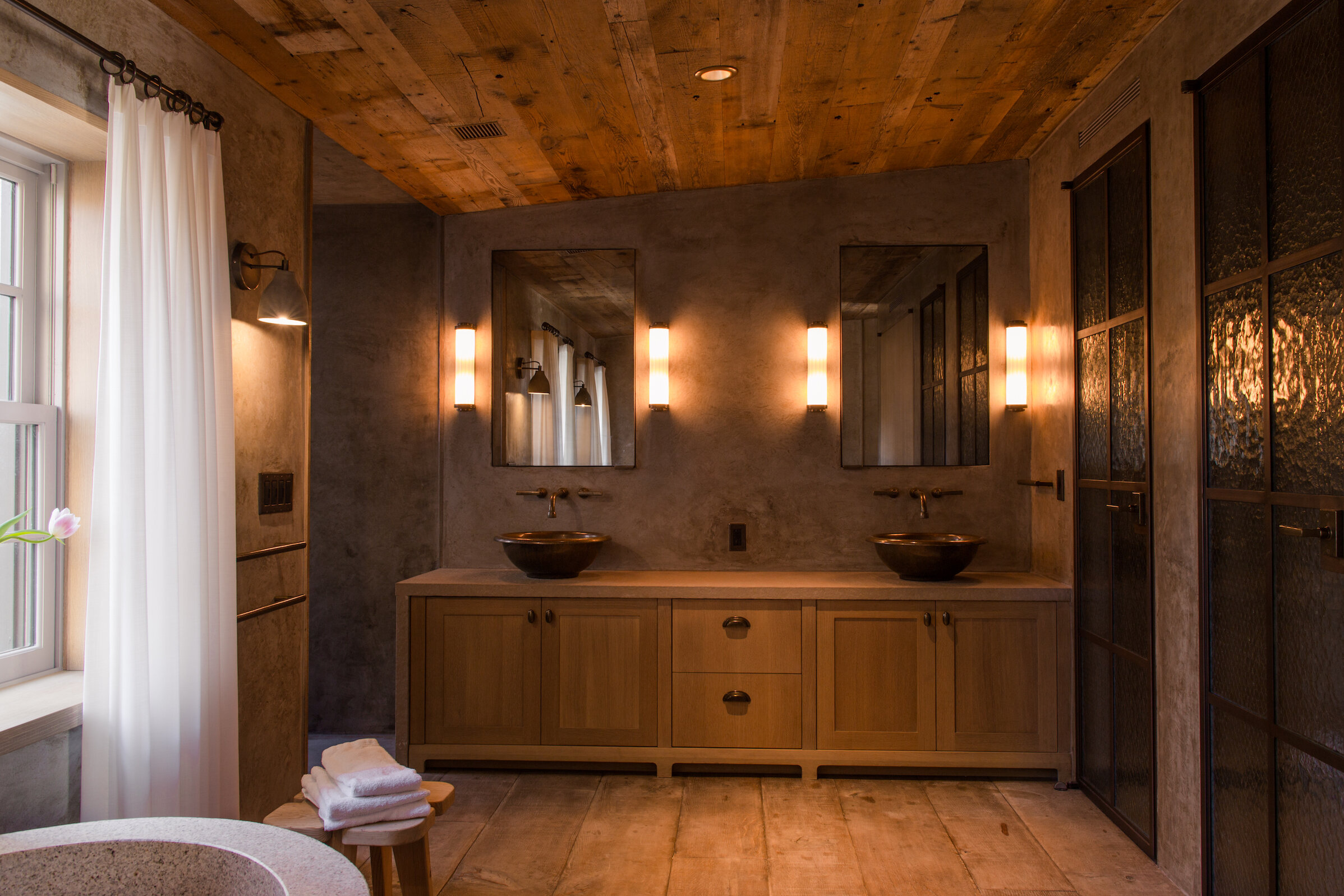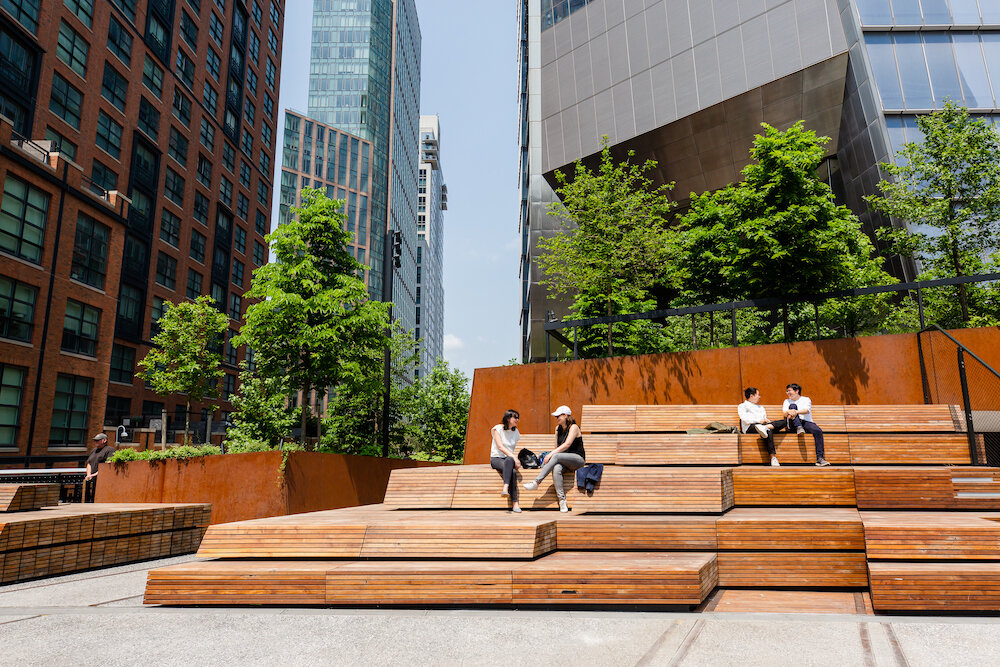Earlier this year, we identified an architectural treasure not far from the Pine Plains Mill: the Federal Style Oliver Bronson House.
Originally built in 1811 as a private residence and later used as a reform school for girls, the Bronson house has sadly fallen into disrepair. But with permission from Historic Hudson, we assembled a team that included our fabricators, installers, photographers, and an inspired stylist. In all, eighteen people over three days helped recreate a world in which The Hudson Company’s flooring—some of it as old or older than the house itself—could exist in a setting full of character and architectural detail.
Special thanks to our friends Colin King, Andrea Gentl, Martin Hyers, and Dani Case.
Antique French Oak
French vintners coined the term terroir to describe the earthy mix of climate, soil, and weather conditions that make wine taste the way it does. There’s no equivalent word to describe lumber, but the concept of terroir applies: every piece of wood on earth originally came from a tree, and that tree grew on a unique patch of soil in its particular corner of the world. The wind, weather, soil and sun make it what it is. That’s why this collection of Antique French Oak is so special, and couldn’t be replicated in any other place.
Sourced last autumn, this wood was salvaged from floorboards in farmhouses east of Paris in the French towns of Metz, Nancy, Dijon, as well as Lorraine and Bougogne in the region of Est. Dating from the 17th and 18th centuries, thesehouses were sturdily built and well loved. You wouldn’t find the kind of high-polish case furniture favored by the various Louis here; instead you’d be enchanted by the rustic simplicity and unspoiled beauty of the architecture and the surrounding countryside. Picture charmingly idiosyncratic paint colors, pictures and lighting fixtures just slightly askew, clean and fresh-smelling tea towels, and the promise of fresh bread each morning. So much history and daily life unfolded in these houses, and some pieces of it are coming to America.
History & Handcrafting on Crosby Street
Underneath a bank of skylights in her Crosby Street loft, with all her tools arrayed on a butcher block work table, artist Jill Platner makes her signature feather-like metal jewelry by hand. She’s developed a method for joining pieces of metal so that it drapes like fabric, and she has an acute feel for the material and knowledge of the tools of her trade. And she does all this inside a Federal style house in NoHo that practically radiates American history. Originally built in 1823 as a townhouse for James Roosevelt, an ancestor of FDR, in the 1850s the building housed a hospital run by Dr. Elizabeth Blackwell, the first American woman to earn a medical degree. With her sister Emily, also a physician (the sisters were the first and third women in America to earn medical degrees, respectively) Blackwell rented the building in 1857 and made it the home of the New York Infirmary for Indigent Women and Children. With the help of wealthy benefactors, many of them Quaker, the Blackwells ran the first hospital in America that was staffed entirely by women.
The hospital ran by Dr. Elizabeth Blackwell that occupied the Crosby Street building in the 1850s.
Platner is fascinated by the building’s past, and her painstaking work renovating the building has revealed tantalizing pieces of its history. When she first toured it as a young designer in need of studio space in the 1990s, she noticed details like the chisel marks on the wooden beams—clearly the handiwork of a skilled craftsman—and recognized something of a kindred spirit. Platner made the light-filled top floor her studio, then expanded into the adjacent carriage house which is where she fabricates jewelry and makes large-scale metal sculptures.
The original flooring before being salvaged and milled by The Hudson Company.
In 2007 when she was preparing to buy her space, Platner discovered the story of the Blackwell sisters. Her top-floor studio was once the dormitory for the physicians and interns, while the lower floors were devoted to the maternity and illness wards, the pharmacy, and the waiting area. By 2012, when Platner became a part owner of the building, it was badly in need of repairs. There were bulging bricks and the roof was in dire straits. But she was committed to keeping intact as much of the building’s original material as she could, and that’s where The Hudson Company came in. Underneath some particle board, she discovered ten-inch wide boards that were original to the house. Well worn and quite uneven, Platner arranged to send the salvaged boards up to Pine Plains where they were milled and finished, then reinstalled. Now even and uniform, but still full of history and character, the floors are back where they belong on Crosby Street. “It looks incredible,” Platner says. “You can feel history in it.”
Jill Platner’s Studio. Photo credit: Aundre Larrow for The New York Times.
Rediscovering Antique Heart Pine in a Historic New England Textile Mill
At The Hudson Company, we reclaim heritage wood sustainably. Often that means salvaging it from beautiful places like this, the Draper Mill building in Hopedale, Massachusetts, where past and present meet. Though it’s quiet today, this mill—spanning over one million square feet—was once a major industrial hub that produced textiles on high-speed power looms. The Draper family built the mill complex in the 19th century using the preferred building materials of the era. One element in particular was exactly what we hoped we’d find when we visited: Antique Heart Pine timber. Milled and finished according to our exacting specifications, this wood will enjoy a second life as the fine flooring, paneling, and beams we are known for. Luckily, we knew just where to find it.
WATCH THE VIDEO ABOVE TO SEE OUR ANTIQUE HEART PINE RECLAMATION.
Inspiration in Imperfection: Reclaimed Wood and JB Blunk's Handcrafted Legacy
JB Blunk’s home on the Inverness Ridge with Redwood Enry Arch, 1976. Photo credit: ©LeslieWilliamson
J.B. Blunk’s art career was probably inevitable one form or another, but it was a chance encounter with Isamu Noguchi in a Tokyo craft shop that put him on course to become one of the most innovative American craftsmen of the 20th century. It was the early 1950s, and Blunk—then a soldier in the US Army, stationed in Korea—was browsing at the craft shop when he met Noguchi who was there with his wife. Yamaguchi Yoshiko. Prior to his tour in Korea, Blunk had been a student at UCLA where he became fascinated by ceramics, and Noguchi decided to introduce him to the Japanese artistic polymath Kitaoji Rosanjin, who made exquisite, rustic and colorful pottery inspired by historical Japanese ceramics, as well as lacquerware and calligraphy. Blunk apprenticed himself to Rosanjin, became a skilled potter in his own right, and later worked for artist Toyo Kaneshige, a Living National Treasure. Returning to California in 1954, he was now energized and inspired to embark on a life in which craft shaped every corner of his life. Blunk’s name isn’t synonymous with midcentury style, and he’s not a household name. (Yet.) But with exhibitions in major galleries, including Kasmin and Blum & Poe, introducing his work to new audiences, his legacy seems to be getting the second look it deserves.
J.B. Blunk in his studio, c.1968. Courtesy: J.B. Blunk Collection
Interior of JB Blunk’s home with river stones and artworks by Blunk. Untitled painting, c.1990, and Redwood stool, c.1965.
Photo credit: ©LeslieWilliamson
J.B. Blunk (1926–2002) was born in Ottawa, Kansas, and studied physics before switching to ceramics in college. Like Wharton Esherick, Blunk was an artist who didn’t make much of a distinction between home and studio. And like George Nakashima, he found much inspiration in the natural structure of wood—its knots, grain, colors, and textures. Blunk settled in the town of Inverness in the mid-1950s, and decided to build a cabin there himself. Now known as the Blunk House, the home was described in T Magazine as “a cottage from a midcentury-modern fairytale.” There’s a potter’s studio with three kilns, and a woodshop. Maria Nielson, Blunk’s daughter, and the author of a book on Blunk’s work, spends time at the house, where her father made everything from the sleeping loft to the ceramics in the kitchen by hand.
Woven into the fabric of the landscape and the house itself is redwood. The table in Blunk’s kitchen is crafted from a gigantic slab of redwood, and they dot the mountainous landscape of Inverness as far as the eye can see. Blunk was active in a variety of media, including clay and cast bronze, but his primary medium was wood. Sometimes a chainsaw was part of the picture. Blunk’s favored wood species was redwood, though he occasionally used cypress. Redwood’s characteristic color and natural softness gives it working properties that are almost clay-like. Blunk would salvage chunks of redwood on the landscape that had been discarded by loggers, and make use of his findings in the ways that best suited their scale. Using his chainsaw, he’d carve chairs out of single pieces of wood, sometimes creating “seating sculptures” that seemed to hover somewhere between sculpture and furniture. According to Mariah Nielson, even the bathroom sink in the Blunk House bears chisel marks.
Interior of JB Blunk’s home with artworks by Blunk, sofa by Max Frommeld, and cushions by Christine Nielson and Nancy Waite Harlow.
Photo credit: ©LeslieWilliamson
From his time studying ceramics in Japan, Blunk was steeped in the aesthetic and philosophical principle of wabi sabi, which is difficult to translate precisely, but in an artistic context means accepting transience and imperfection, finding beauty in it, and not trying to “fix” anything about an object. Wabi sabi had a powerful influence on both historical Japanese crafts and on mingei, the Japanese craft revival movement that emerged there in response to industrialization in the 1930s, and was several decades underway when Blunk visited Tokyo.
A wabi sabi approach to craft could mean embracing asymmetry, or a nick or a scratch, or a perceived flaw in a piece of wood—like a discarded burl of no interest to commercial loggers. Blunk took the lesson of his craft training and applied it to working with reclaimed wood. Natural “flaws” became centerpieces, and odd shapes were just another form of inspiration. A major work entitled “The Planet,” completed in 1969, can be viewed at the Oakland Museum of California. It’s made from a single, the enormous root structure of a redwood—the only remains of a long-dead tree. It was typical of Blunk to salvage something that others had overlooked, and to create from it something unique, odd, and beautiful, that seemed at once ancient and modern. Perfection isn’t easy. But imperfection, at its best, is even harder to achieve. It seems safe to say that J.B. Blunk nailed it.
Reflecting on THE legacy of artistic problem-solver Wharton Esherick
If you’re familiar with the work of Wharton Esherick (1887–1970), you’re probably imagining the most famous spiral staircase in Pennsylvania right now. Built in 1930 to replace a traditional staircase, it’s tightly curled and elegantly carved from red oak, with a rustic form that appears to defy gravity. Its thick treads seem to float as they spiral around a curvy central column. They’re actually mortised in place and supported by tenons, but the lack of any supporting structure (apart from a mastodon tusk handrail that was added in the late 1940s) gives the staircase an air of magic. It’s just one example from a long career in which Esherick seemed to ask himself what he could do with wood, and never backed away from a surprising answer. Unorthodox solutions and clever workarounds abound in his unique home and studio in Paoli, PA, which is now the site of the Wharton Esherick Museum. And that makes sense, because he never trained as a woodworker; first and foremost he was an artist, and he was able to fashion wonders from any material, never letting the strictures of carpentry fence him in.
The Spiral Staircase in Wharton Esherick's home and studio, 1930.
Photo credit: ©LeslieWilliamson from Handcrafted Modern, Rizzoli, 2010.
Wharton Esherick in his studio with his sculpture Oblivion (dated
1934.) Photo credit: c. 1934 by Emil Luks. Image courtesy of the
Wharton Esherick Museum.
Famous for saying “If it isn’t fun, it isn’t worth doing,” Esherick crafted furniture, made sculpture, designed lighting and interior fittings, and even whole buildings. He’s considered an icon of the Studio Furniture Movement of the mid-20th century, and having lived and worked in Bucks County, he’s also linked to a group of important Pennsylvania makers of his era: George Nakashima, Phillip Lloyd Powell, and Paul Evans. He came from a well-to-do Philadelphia family, and studied printmaking and drawing at the Pennsylvania Museum School of Industrial Art (now known as the University of the Arts), then painting at PAFA, the Pennsylvania Academy of Fine Arts. He was discovering the world of painting just as American Impressionism was flourishing in Philadelphia and Bucks County. Esherick and his wife Letty settled in Paoli after finishing school and bought an historic farmhouse. Here he became interested in carpentry and the sculptural possibilities afforded by wood.
Esherick initially carved woodcuts—a natural outgrowth of his printmaking practice from art school—then he began making abstract sculptures from wood from in the 1920s. In 1926 his work was exhibited at the Whitney Museum of American Art. He then embarked on the long process of designing and building his own home and studio. And by the mid-1930’s, he was creating elaborate interior elements for local clients such as his famous doorway and fireplace for the Curtis Bok House. Considered some of his most important works, the dramatic doorway was meant to evoke the look of draping fabric, while the fireplace, which echoes Art Deco design but veers toward a more extreme, angular style, was inspired by the dramatic shadows cast by a roaring fire.
Fireplace and door by Wharton Esherick from the Curtis Bok House,
1935. Image courtesy of the Wharton Esherick Museum.
“A Pennsylvania Hill House” designed by architect George Howe for
the "America at Home" display at the 1939 World's Fair. Photo by Richard Garrison. Image courtesy of the Wharton Esherick Museum.
Over the next several decades, his work was hard to pin down stylistically. Some works were crisp and geometric like the Bok House architectural elements. Others, like his own staircase and the biomorphic, abstract forms he sculpted, were soft and organic. In 1940, he created a suite of furniture for the exhibition “America at Home” for the 1939-1940 New York World’s Fair. Sixteen architects were invited to design rooms for the exhibition showcasing new American designs, and architect George Howe, who designed Philadelphia’s PSFS building on Market Street, invited Esherick to take part. Howe’s room was called “A Pennsylvania Hill House,” and its design captured the mix of modern and rustic style that was emerging in places like Bucks County in the middle decades of the 20th century. Esherick’s contributions to the exhibition included a sofa from the Bok house, the famous spiral staircase, a five-sided hickory table, and cherrywood wall panels. This exhibition represented the first time that Esherick’s work was seen by a wide-ranging public. Lousie V. Sloane, who was in charge of publicity for the “America at Home” display, wrote in a letter to Esherick that “The ‘Pennsylvania Hill House’ is a very popular room with visitors… and the stairway continues to bring forth exclamations, questions and comments from those who go through the building.”
By his later years, Wharton Esherick was known among colleagues and admirers as the “Dean of American Craftsmen.” His work would eventually earn him a retrospective at the Museum of Contemporary Crafts (now the Museum of Arts and Design) in 1958, and a Gold Medal from the New York Architectural League. His work is included in the collections of the Renwick Gallery of the Smithsonian Institution in Washington, D.C., Metropolitan Museum of Art, The Whitney Museum of American Art, the Philadelphia Museum of Art, the Museum of Fine Arts Boston. One legacy of Esherick’s earliest years working with wood—and a renewable form of accessible art—are his printed holiday cards.
When he was first settling in Paoli and exploring his new surroundings, he made prints that captured the seasons, and his snow-covered scenes of houses and hills were very popular when he made them (and they still are today.) One such print, called “January,” appeared in The Century Magazine, and other prints of his were published in Vanity Fair and The New Republic. “January” depicts a person walking up a road blanketed with snow, with a single blackbird perched on a nearby fence, and four more circling overhead. Using the end grain of a block of wood to create the image, he carved away much of the lower third of the print to leave a pillowy expanse of pristine snowfall. It has an air of mystery, with frost disguising the landscape underneath, and the figure faces away from us. Looking at this image now, it seems quite modern for 1923. And in 2020, there’s something uncannily familiar about it. This holiday season, marked in so many ways by the COVID pandemic, means that many of us have carved out small groups to celebrate with, and some of us will celebrate solo. It feels strange, and it’s not easy. Esherick’s print is not overtly “Christmas-y,” and contains no text, but its single figure with his neighborly birds sends us a timely and powerful message. The only thing to do, especially in the cold and unknown, is to walk straight ahead.
“January”, 1923, wood engraving by Wharton Esherick. Image courtesy
of the Wharton Esherick Museum.
The Finishing Touch on a New York Showroom
If Schotten & Hansen had a kindred spirit in the interior design world, it may have been Christian Liaigre, the French designer of furniture and interiors who passed away in September aged 77. Back in 2018, his eponymous firm opened a new showroom on 29th Street in Manhattan’s Nomad district, where his signature aesthetic—described in The New York Times by Penelope Green as “muscular and elegant”—was made manifest with flooring from Schotten & Hansen. Liaigre was devoted to fine craftsmanship, and admired the skill of accomplished makers. He designed interiors for Calvin Klein and Karl Lagerfeld, and he loved using elemental materials like bronze, stone, and wenge wood. He’s also credited with pioneering the concept of the boutique hotel, having designed SoHo’s Mercer Hotel in 1997—his first big project in the United States.
Liaigre showroom, New York City.
Hotel Montalembert, Paris.
Born in 1943 near La Rochelle, Liaigre studied at the École des Beaux-Arts and the École Nationale Supérieure des Arts Décoratifs in Paris. His inspiration came from an array of sources, many of which, like African art, had widely influenced French Modernism. He was also the grandson of a horse breeder, and growing up he studied the ingenious design and construction of saddles, bridles and stirrups carefully. He liked exposed joinery, and disliked applied ornament, which meant his interiors and furniture were in sync with the pared down modern look of post-industrial lofts in the 1990’s and 2000’s.
He designed the Hotel Montalembert in Paris for a 1990 renovation before moving to the United States, and there he made bold, eclectic choices like pairing carved African sculptures with Ancien Régime furniture. He was also famous for a stool he designed in homage to Brancusi’s “Endless Column,” a square block of wood that flares out at a dramatic angle at the top, forming a primitive seat.
Liaigre showroom, New York City.
Custom floors by Schotten & Hansen at the Liaigre Showroom, NYC.
Liaigre’s reverence for craftsmanship comes through in the design of his New York showroom. The floors are Schotten & Hansen’s Shrunk Face European Oak, which is a light, straw-colored wood (the color is custom, in fact) and adds a depth of natural texture to the crisp space, emphasizing Liaigre’s particular love of wood in all its subtle variation. The interior is meant to be a neutral setting in which to stage Liaigre’s pieces of furniture and lighting, which are invariably bold in design, at times massive, understated in color, and usually sumptuous in their material.
Shrunk Face Oak is now available in 20 colors at our New York showroom through the Schotten & Hansen Collection for The Hudson Company.
A Thousand Skills: George Nakashima
You’ve probably seen George Nakashima’s furniture in the pages of shelter magazines, at auction, and in museum and gallery exhibitions across the country. His aesthetic influence is everywhere: your favorite cafe might have an eye-catching espresso bar with a live edge, or you might see a midcentury-style bench you like at a mass-market furniture retailer that ‘echoes’ one of Nakashima’s designs, to put it diplomatically. Or you might have heard his name and seen photographs of him with his family in an episode of the series Artbound on KCET, “Masters of Modern Design: The Art of the Japanese American Experience,” which tells the story of some of the renowned artists and designers who spent time in internment camps during World War II. Writing in Curbed in 2017, the architecture critic Alexandra Lange examined the connection between American design history and Executive Order 9066, which President Franklin D. Roosevelt signed in 1942. The order granted authority to the military to transport citizens to “relocation centers” in Arkansas, Arizona, California, Colorado, Idaho, Utah, and Wyoming. We call them internment camps today, and about 119,000 people—most of them Japanese immigrants or Japanese-Americans—were sent to live there for several years during World War II. George Nakashima was among them, as were the artists Ruth Asawa and Isamu Noguchi.
Nakashima was already a citizen of the world prior to the war, having spent a year traveling abroad on a round-the-world steamship ticket after graduate school. Born in 1905 in Spokane, Washington to Japanese emigré parents, he grew up hiking and camping in the forests of the Pacific Northwest with the Boy Scouts. He studied forestry at the University of Washington-Seattle, but was drawn to design as well, and graduated with a BA in architecture in 1929. He earned an MA in architecture from M.I.T. in 1931, and embarked on his world tour, spending a bohemian year in France, then traveling to North Africa, and finally to Japan. Nakashima met and eventually worked for the American architect Antonin Raymond, an associate of Frank Lloyd Wright, and he toured Japan studying building techniques and design. In the late 1930s, he was the project architect on the Golconde Dormitory at the Sri Aurobindo Ashram in Pondicherry, India, where he discovered two practices that would shape his life: yoga and furniture-making.
He returned to Japan in 1940, where he met the woman who would become his wife, Marion Okajima, and the two settled in Seattle after marrying in Los Angeles. But in 1942, now with a new daughter named Mira, the Nakashimas were sent to Camp Minidoka, an internment camp in Hunt, Idaho. Incredibly, he used the time there to apprentice himself to a woodworker named Gentauro Hikogawa who had been trained in Japan. Hikogawa taught Nakashima to work expertly with Japanese hand tools and helped him master Japanese joinery techniques. He used whatever wood scraps he could find to practice his craft and develop his first designs for furniture. In 1943, his old mentor Antonin Raymond sponsored the Nakashimas for early release, and offered them his chicken farm in rural New Hope, PA as a place to stay. Mira Nakashima recalls that her father believed the name of the small town—which was becoming a mecca for woodworkers at the time—augured well for a fresh start. Nakashima quickly made connections with Knoll, for whom he designed several furniture lines such as the Straight Back Chair, and he designed a sofa for Widdicomb-Mueller which has gone back into production.
But most of Nakashima’s works were unique. He was famous for using butterfly joints, which allowed him to select unusual, asymmetrical pieces of wood and transform them into inviting dining tables and coffee tables. Nakashima had numerous lifelong clients, and he often signed their names in ink on boards that he selected especially for them. The largest private collection of Nakashima furniture was, for a time, that of Nelson and Happy Rockefeller, who owned over 200 works that Nakashima had designed for their Pocantico Hills estate. His passion for architecture, like his passion for forestry and trees, never wavered, and he was able to weave all three activities together at his home and studio. He designed buildings on his property, and was especially enamored of parabolic shapes, which led to the creation of a line of chairs called “Conoid,” with gently curved backs, which were named for the dramatic roofline of a building he called the Conoid Studio. In a sense, Nakashima didn’t believe in flaws. In his 1981 book The Soul of a Tree, which offered a glimpse at his philosophy and his technique and life story, he wrote: “Each flitch, each board, each plank can have only one ideal use. The woodworker, applying a thousand skills, must find that ideal use and then shape the wood to realize its true potential.”
Nakashima’s Conoid Studio in New Hope, PA. Courtesy of George Nakashima Woodworkers.
The George Nakashima House, Studio and Workshop is now a United States National Historic Landmark and a World Monument, and although it’s temporarily closed as of July, 2020 due to the pandemic, the site is generally open to visitors. Today, Nakashima’s daughter Mira, who is an accomplished designer herself, works alongside a team of highly skilled woodworkers to produce both classic and new designs. A grant from the Getty Foundation has helped in the preservation and conservation of the site and its many unusual structures. There’s a museum and gallery in the city of Takamatsu, Japan where Nakashima once had a studio. In 1983, the man who once jokingly referred to himself as a “Japanese Quaker” was presented with the Order of the Sacred Treasure by the Emperor of Japan and the Japanese government. A key figure in American Modernism who spent most of his life in Bucks County, PA, Nakashima deftly combined the woodworking and design traditions of the United States and Japan. Despite his harrowing wartime experience as a Japanese American during the conflict that pitted the two countries against one another, he seemed to remain deeply rooted, aesthetically and philosophically, in both worlds.
The West Village Townhouse
At The Hudson Company we often reclaim wood from centuries-old barns in rural areas that are miles from the nearest town. But occasionally we find antique treasures in buildings that are right around the corner from the entrance to the nearest Manhattan subway station. For a project with architect David Bucovy in Manhattan’s West Village, we actually salvaged, milled and re-installed wood that was found within the structure of the jobsite itself—adaptive reuse at its best.
The house sits along one of Greenwich Village’s most beautifully preserved historic streets, and likely dates from the 1840s, according to Bucovy. Over the years it had been occupied by a cast of New York characters, and though it was originally designed as a single-family home, it was later subdivided into apartments, and even housed a dentist’s office for a time. By the time Bucovy encountered it, the whole building needed structural work, so it was a prime candidate for a gut renovation, which he undertook with Scordio Construction. (The landmarked exterior remained as-is).
Some architects and designers approach renovations like this one with an eye toward preserving or reanimating a 19th century aesthetic, recreating interior details that look the part, or finding period-appropriate lighting fixtures and mirrors to visually root the home in another era. Bucovy and his client took a totally different approach: “We had a desire to make it primal and real, rather than a textbook ‘authentic,’ museum-like renovation.” The client wanted to avoid an all-white kitchen and high-gloss paint, and use old world materials instead. “It’s a house about materiality,” Bucovy says, “the story that hand-wrought plaster tells, or woodgrain.”
The home’s renovated interior doesn’t recall that of a typical West Village row house so much as a château in the South of France, with exposed beams, rustic antiques and kitchen tools, and warm plaster walls throughout. The design team avoided painted gypsum board, and instead used a method called tadelakt, a plastering technique popular in Morocco and other parts of North Africa, in which marble dust and plaster are burnished to make a waterproof wall surface. It can be dyed with umber, and has an earthy, ancient look and feel (and indeed, the technique dates back to ancient Rome).
It turned out that some of the original, 19th century wood used throughout the house—a mix of Hemlock, Pine and Spruce, probably local—was perfect for their needs. We worked with the homeowner and the demolition crew and were able to salvage structural timbers and softwood joists. We brought it up to our mill in Pine Plains and processed it as we usually do: removing old nails, resawing and kiln-drying it, ripping, planing, profiling and end-matching the boards so that they could be reinstalled as ceiling and wall panels. We kept the Original Face, which is weathered through a mix of oxidation, patina, and signs of historic use. Bucovy especially likes Original Face for the way “it records its history and imperfections,” he says.
This aesthetic of exquisite imperfection runs through much of the home’s design and the works of art that the owner installed throughout: wabi-sabi, which is a Japanese concept characterized as the acceptance of imperfection and impermanence. Rooted partly in Buddhist ideals, wabi-sabi celebrates the off-kilter beauty that can be found both in nature and in works of art and design that are asymmetrical, rough, or austere. Bucovy finds inspiration in this concept, and his client happens to be a serious collector of postwar Japanese and Korean art. The aesthetics of these paintings and sculptures happen to dovetail seamlessly with the rustic European look of the interior. Bucovy and the homeowner worked together and sourced both old and new pieces from Belgian art and antiques dealer Axel Vervoort, whose sophisticated farmhouse aesthetic has inspired a renewed enthusiasm for primitive antiques that has thrived despite the lasting dominance of Modernism.
Alongside works of abstract art from Japan and Korea, there are butter-making tools, ceramics, baskets and pieces of furniture dating back to the 1700’s across various parts of Europe. There are Buxy limestone countertops from an extinguished quarry in France. All of these touches complement the wall treatments, hardware and the wood paneling, which has its own story to tell, from 1840’s Greenwich Village, up to the Hudson Valley, and back again in the 21st century.
The Hudson Company on the High Line
New York’s High Line is renowned as a botanical oasis in the middle of the busy, formerly gritty neighborhood of West Chelsea. With plantings thoughtfully chosen by Dutch landscape architect Piet Oudolf, the elevated park is home to over 120 species: coneflowers, sumac, grasses and birch trees, to name just a few. Some are native to the region, and some are exotic. But plant diversity on the High Line isn’t restricted to the living specimens that make it lush and green. Thanks to the success of The Hudson Company’s wood-sourcing trip to India in 2017, there is teak to be found on the High Line in benches, steps, seating and furniture. The journey of this wood from a teak forest somewhere in Southeast Asia centuries ago, to exquisite buildings in Hyderabad’s old Muslim quarter, to New York City’s High Line illustrates how architectural preservation—even the accidental kind—can give materials a second life when they’re salvaged sustainably.
Teak, known to botanists as tectona grandis, evolved for harsh conditions, which is why it’s long been a popular choice for decking material, outdoor furniture, and boats. It’s native to the hot, tropical climates of India, Malaysia, Thailand, Bangladesh, Indonesia and Sri Lanka, and it’s cultivated in parts of Africa and the Caribbean, but half the world’s naturally occuring teak comes from Myanmar. Teak is a hardwood with a high oil content and tight grain, which gives it great tensile strength and a natural resistance to weather. It’s so strong, in fact, that it can wear out metal tooling and blades over time. It’s also very insect-resistant, and tends to be impervious to termite infestations. All of these qualities have led architects and builders in tropical climates to choose teak for centuries, using it to construct doors, beams, wall panels, and floors. Intricately carved screens and pilasters made from teak can be found in buildings throughout Southeast Asia.
One of the great places to source vintage teak wood elements today is Hyderabad, India. Today, Hyderabad is widely known as one of India’s largest high tech centers (it’s nickname: Cyberabad) and travelers who visit on business are likely to spend most of their time in the city’s modern downtown, which is full of glass and steel high-rises. But old Hyderabad is a treasure trove of historic temples, mosques and houses dating from the 16th century, including Golconda Fort, a former center for the diamond trade and the capital of the Qutb Shahi dynasty. Hyderabad’s historic architecture is distinct, with elements of Hindu and Muslim styles reflecting its complex cultural heritgage.
Buildings from the 16th and early 17th centuries built during the Qutb Shahi period drew design elements from Persian architecture, with domes and soaring arches. At the beginning of the 18th century, Mughal rulers were responsible for building Hyderabad’s city wall. The families of the Nizam dynasty, which followed the Mughal era and ruled Hyderabad from 1724-1948, built palaces in an increasingly European style, because they ruled as vassals of the British Empire. All of these successive dynasties in Hyderabad represented a mix of different cultures and religions, and as with much of India—and multi-ethnic cities around the world—various populations tended to remain in their enclaves.
Because it resisted westernization and modernization in the latter part of British period, the largely Muslim older sections of Hyderabad tended to remain intact, if a bit down at the heels. This meant that much of the historic architecture escaped the rush of bulldozing and new construction that has transformed the city’s modern, high-tech center, and remains a key source of beautiful old teak wood. When The Hudson Company visited, we made trips to two sites where well-preserved teak can be found. Demolition in the old city yielded boards as long as 22 feet, some dating back to the 17th century or even earlier. Then we worked with an aggregator who organizes auctions of antique beams, boards, doors, and exterior elements. Ultimately, we gathered 10,000 BF (that’s one shipping container’s worth) of teak, and sent it to our facility in Pine Plains where it was milled. We worked with Friends of the High Line and Sciame Construction to source the wood and find what was needed to craft seating, steps, and other design elements. It’s gratifying to see that these pieces of antique timber, which grew centuries ago in India or elsewhere in Southeast Asia, survived long enough in the buildings of old Hyderabad to be harvested and given a second act in New York City. Visitors may not know the wood’s story, but they can admire its natural beauty and appreciate its impressive weather-resistance on a blustery New York day.










